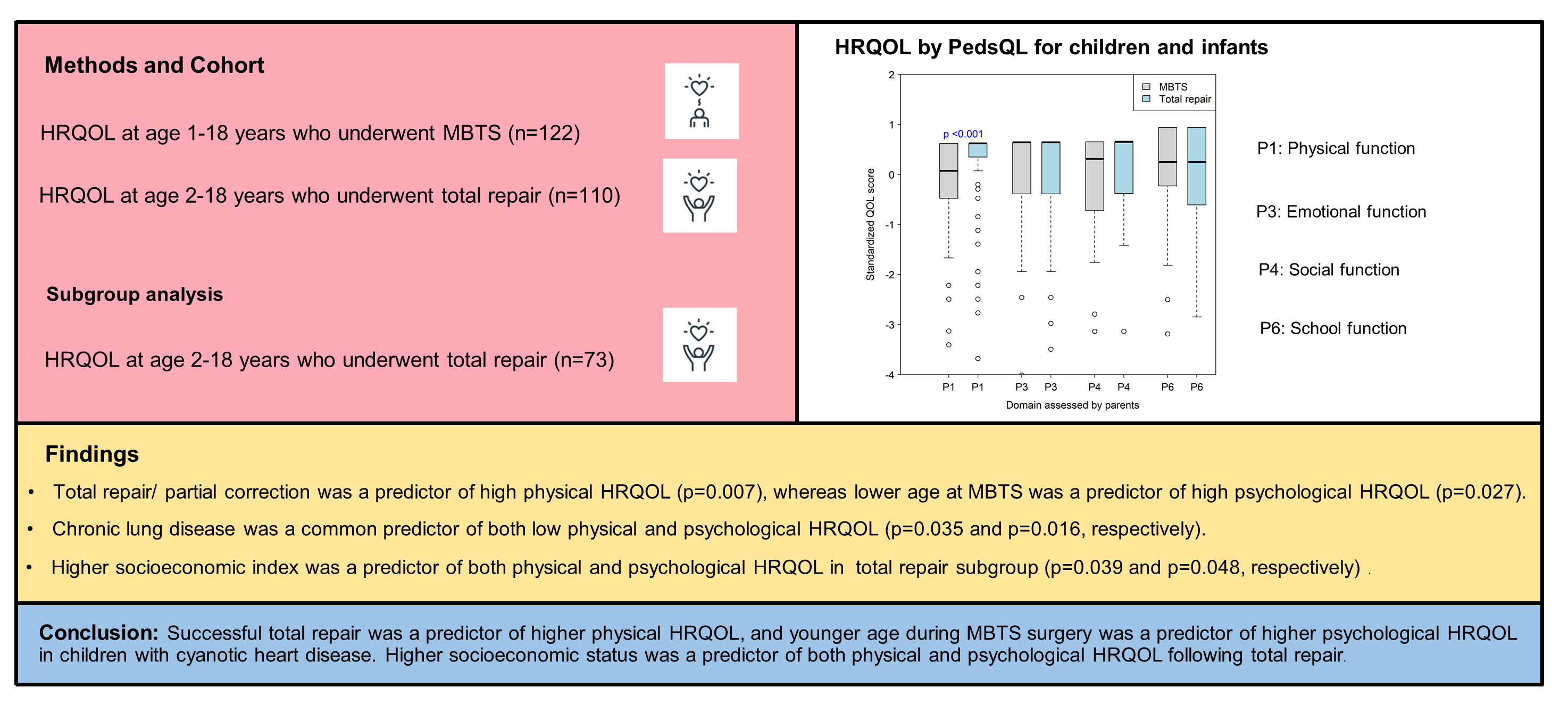 Open Access
Open Access
ARTICLE
Predictors of Health-Related Quality of Life in Children with Cyanotic Heart Disease Who Underwent Palliative and Total Repair
1 Department of Anesthesiology, Faculty of Medicine, Prince of Songkla University, Songkhla, 90110, Thailand
2 Department of Surgery, Faculty of Medicine, Prince of Songkla University, Songkhla, 90110, Thailand
3 Department of Pediatrics, Faculty of Medicine, Prince of Songkla University, Songkhla, 90110, Thailand
* Corresponding Author: Maliwan Oofuvong. Email:
Congenital Heart Disease 2022, 17(3), 245-267. https://doi.org/10.32604/chd.2022.021778
Received 04 February 2022; Accepted 22 March 2022; Issue published 03 May 2022
Abstract
Background: Studies on predictors of health-related quality of life (HRQOL) in pediatric patients with cyanotic heart disease who are waiting for the next stage and those who have undergone total repair are scarce. Therefore, we aimed to identify such predictors in children who received the modified Blalock–Taussig shunt (MBTS) and those who underwent total repair. Methods: In this historical cohort and concurrent follow-up study, data of children who underwent MBTS at the age of 0–3 years between January 2005 and December 2016 at a super-tertiary care hospital in Southern Thailand were obtained. Children who were alive in December 2017 were recruited to evaluate the quality of life at least 1 year after their operation. Between January and December 2018, the “Pediatric Quality of Life Inventory 4.0 Generic Core Scales” with both child self-report and parent proxy-report scores were used to examine the HRQOL. Multivariate linear regression analysis was performed to identify independent predictors of HRQOL. Beta-coefficient (β) and 95% confidence intervals (95% CIs) were calculated and considered statistically significant at p < 0.05. Results: Among the 380 enrolled children, 148 died, 122 survived and waited for total repair, and 110 survived after total repair. In the multivariate analysis, chronic lung disease was a common predictor of lower physical and psychosocial HRQOL reported by the parents (β [95% CI]: −0.42 [−0.81, −0.03] and −0.49 [−0.89, −0.09], respectively). Total repair was a predictor of higher physical HRQOL according to both parents and children (β [95% CI]: 0.33 [0.09, 0.57] and 0.70 [0.36, 1.03], respectively). A predictor of higher psychosocial HRQOL reported by the parents was younger age during MBTS surgery compared with older age (β [95% CI]: 0.012 [0.001, 0.022]). In the total repair subgroup, undergoing the Fontan procedure (vs. Glenn procedure) was a predictor for lower physical HRQOL reported by the parents (β [95% CI]: −0.82 [−1.52, −0.13]). Higher socioeconomic status was a predictor of both physical and psychosocial HRQOL (β [95% CI]: 0.018 [0.001, 0.034] and 0.012 [0.0001, 0.04], respectively). Conclusions: Successful total repair was a predictor of higher physical HRQOL, and younger age during MBTS surgery was a predictor of higher psychological HRQOL in children with cyanotic heart disease. Higher socioeconomic status was a predictor of both physical and psychological HRQOL following total repair [Thai Clinical Trials Registry: TCTR20161221003].Graphic Abstract

Keywords
Cite This Article
 Copyright © 2022 The Author(s). Published by Tech Science Press.
Copyright © 2022 The Author(s). Published by Tech Science Press.This work is licensed under a Creative Commons Attribution 4.0 International License , which permits unrestricted use, distribution, and reproduction in any medium, provided the original work is properly cited.


 Submit a Paper
Submit a Paper Propose a Special lssue
Propose a Special lssue View Full Text
View Full Text Download PDF
Download PDF Downloads
Downloads
 Citation Tools
Citation Tools